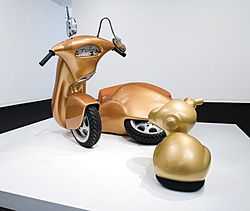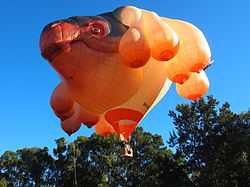Patricia Piccinini



Patricia Piccinini (born 1965) is an Australian artist who works in a variety of media, including painting, video, sound, installation, digital prints, and sculpture. In 2014 she was awarded the Artist Award by the Melbourne Art Foundation's Awards for the Visual Arts. [1]
Works
According to the Art Gallery of South Australia, Australia:
Piccinini has an ambivalent attitude towards technology and she uses her artistic practice as a forum for discussion about how technology impacts upon life. She is keenly interested in how contemporary ideas of nature, the natural and the artificial are changing our society. Specific works have addressed concerns about biotechnology, such as gene therapy and ongoing research to map the human genome... she is also fascinated by the mechanisms of consumer culture."[2]
The Skywhale was a work commissioned by the ACT Government for its Centenary year. The ABC described the work as a "hot air balloon in the shape of a tortoise-like animal featuring huge dangling udders made from four hectares of nylon." [3] The balloon cost $300,000 and has been the subject of comments made by ACT Chief Ministers Jon Stanhope and Andrew Barr. [4][5]
In 2015 she presented as part of a group exhibition titled Menagerie at the Australian Centre for Contemporary Art, Melbourne. [6]
Responses
In a 2015 interview on ABC Radio, Patricia Piccinini explained to Sarah L'Estrange that some people may mistakenly identify her work as that of a "Horny Lezzo". In the interview, Sarah L'Estrange asked: "Why is this particularly the bravest thing you've done?". Piccinini replied: "because (the artwork) can be so easily dismissed. People could easily say ""Oh, look at that Horny Lezzo, making these repugnant images."" But it's not that. They're the opposite of that" [7]
In a 2014 interview with the Sydney Morning Herald, Piccinini said of her work, "It’s about evolution, nature – how nature is such a wonderful thing, we’re just here to witness it, it’s not here for us – genetic engineering, changing the body." [8] Following her 2014 win in the Melbourne Art Foundation's Awards, she went on to say that:
‘‘The thing about this award on some levels is that my work ... all of it has this first impact, the sort of impact of spectacle. It’s beautifully made, strong, aesthetic, so people are interested in that and it draws them in, and then they get interested in the idea. It takes a while to get to the idea. It’s not easy. So this award says, 'We get it, we get what you’re trying to do, we’ve gone beyond the surface, we can see that there are ideas underneath, and these ideas are about the opportunity for connection’.’’ [9]
See also
| Wikimedia Commons has media related to Patricia Piccinini. |
- Frankenstein argument
- Parahuman
- Ron Mueck (similar artist)
- Australian art
References
- ↑ http://melbourneartfoundation.com/2014-awards-winners-announced/
- ↑ "Biography: Patricia Piccinini". National Gallery of Victoria. 2002. Archived from the original on 2008-04-03. Retrieved 2008-06-21.
- ↑ http://www.abc.net.au/radionational/programs/booksandarts/artist-patricia-piccinini-honoured/5650036
- ↑ http://www.abc.net.au/news/2015-03-06/act-chief-minister-accidently-kills-off-skywhale-in-radio-gaffe/6285356
- ↑ http://www.abc.net.au/radionational/programs/booksandarts/artist-patricia-piccinini-honoured/5650036
- ↑ https://www.accaonline.org.au/exhibition/menagerie
- ↑ http://mpegmedia.abc.net.au/rn/podcast/2015/02/bay_20150220_1025.mp3
- ↑ http://www.smh.com.au/entertainment/art-and-design/skywhale-creator-patricia-piccinini-wins-national-art-prize-20140717-zu4gd.html
- ↑ http://www.smh.com.au/entertainment/art-and-design/skywhale-creator-patricia-piccinini-wins-national-art-prize-20140717-zu4gd.html
External links
|